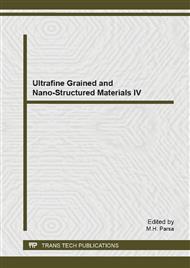p.698
p.703
p.707
p.712
p.717
p.722
p.727
p.732
p.737
Improvement and Red Shift Toward Visible Spectrum of TiO2 Nanofibers through Doping by Fe2O3 and Nitrogen
Abstract:
TiO2 has many applications as photocatalyst, photo/electrochromic device, solar cell and sensors. It has been activated only by UV light. In this research we have been investigated on the effect of adding Fe2O3 nanoparticles and N on the absorption spectrum in order to increase their activity and shift toward visible light for TiO2 nanofibers. We used electrospining method to fabricate nanofibers. Sol gel for spinning pure nanofibers contains Titanium tetraisopropoxide (C12H28O4Ti), acetic acid (CH3COOH), ethanol (C2H5OH) and PVP (C6H9NO-12 wt.% ). Then we used Fe2O3 nanoparticle (size: 2040 nm, purity: 98%) and HNO3 acid for doping. Among Fe2O3-doped samples, the 2.1 wt% Fe2O3 indicated the highest activity for visible light, while with HNO3, excellent photo-catalyst activity obtained at 1.5wt% Fe2O3 and 5 wt% HNO3(purity :65%). The final solutions were stacked into the syringe and joined to a high voltage DC supply. A piece of glass stacked on aluminum foilwas used as collector. Finally nanofibers calcined at 500°C. FESEM, XRD and Spectrophotometry techniques were employed to deliberation nanofibers. Diameter of the fibers was approximately 100 nm (anatase: 77%). The Fe2O3-TiO2 and Fe2O3-N-TiO2 nanofibers indicated respectively 50% and 80% growth in absorption intensities under visible light irradiation compared to pure nanofiber and absorption spectrum peak moved towards larger wavelengths (70 and 100nm) when TiO2 doped with Fe2O3 and Fe2O3-N. Keywords:Fe2O3 nanoparticle; nitrogen; red shift; TiO2nanofiber; UV-visible irradiation.
Info:
Periodical:
Pages:
717-721
Citation:
Online since:
November 2013
Authors:
Price:
Сopyright:
© 2014 Trans Tech Publications Ltd. All Rights Reserved
Share:
Citation:


